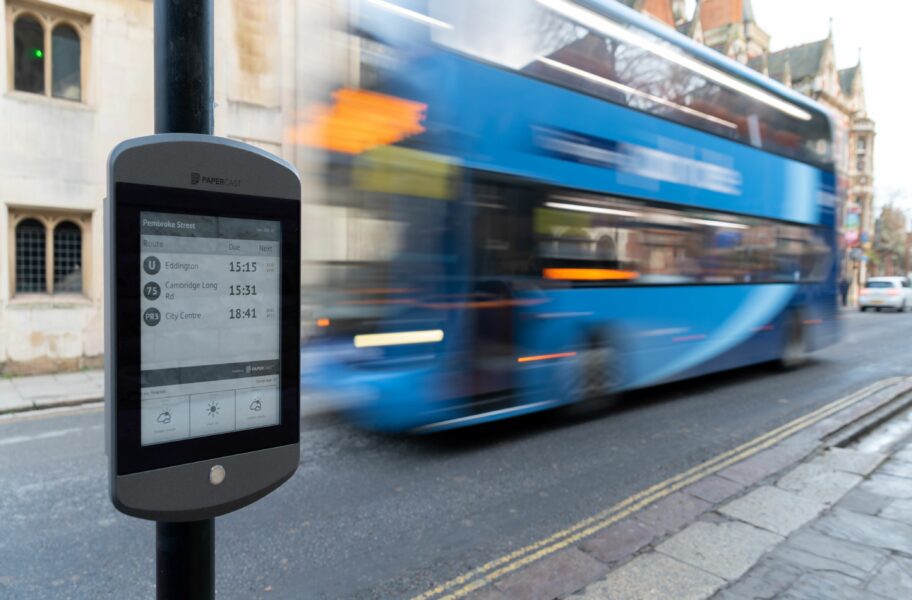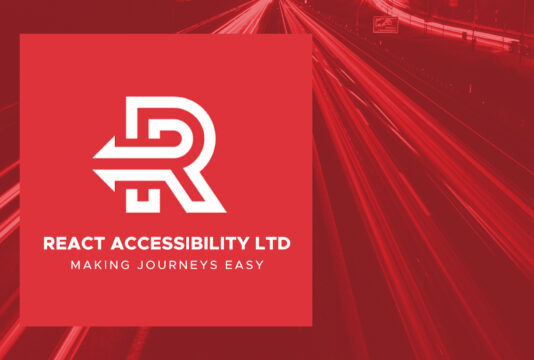
Meet the Papercast CMS Layout Catalogue: A must have resource for sharing visually impactful passenger information
We’re excited to tell you about the Papercast Content Management System (CMS) Layout Catalogue, an…

The virtues of e-paper as a passenger information display technology is increasingly being embraced across the public transport sector.
We have seen major transport hubs around the world implement e-paper passenger information displays. In fact, Papercast technology is behind many high profile public information initiatives worldwide – UK, France, Germany, Abi Dhabi, Dubai, Singapore, Japan, Australia, New Zealand, USA, Canada and more – and why we were awarded the Queen’s Award for Enterprise International Trade in 2021.
The reality is that e-paper is now becoming the de-facto technology for forward thinking public transport providers that need to get live information to customers in a sustainable manner, and to locations where mains power is not readily available.
Over the last 5 years, we have written many articles on the benefit of real-time passenger information at bus stops and e-paper technology (and of course, Papercast specifically). Here we pull the highlights into one place. If you want a quick overview of how e-paper works, check out this video from E Ink (the manufacturer of the e-paper panels used in our products).
The benefits real-time passenger information at bus stops
With a vision to bring information to life, we are committed to ensuring that our e-paper technology remains at the forefront of making this a reality. We leverage our strength as a technology innovator to continually push the limits of our proprietary hardware and software, while incorporating components from category leaders where it makes sense.
Here are the top 10 things you need to know about e-paper technology and Papercast solutions.
E-paper is the only display technology that delivers high resolution content in direct sunlight without any degradation in clarity. Content is as clear as it would be on real paper, no pixilation, distortion or glare. This is because it is reflective, whereas LCD screens are ‘emissive’ using power-hungry backlighting to illuminate pixels. With inbuilt low-power illumination, Papercast displays are crystal clear at night too.
It takes no power at all to display an image on e-paper and only a little power to change an image (in contrast LCD screens need refreshing around 30-times per second). This makes it the lowest power display technology in the world.
What’s more, Papercast has engineered its electronics to the very limits to provide industry-leading power efficiency, making it one of the most sustainable outdoor display solutions available on the market – consuming around 3x less power than comparable e-paper solutions and up to 32x less than other display technologies.
Another advantage of e-paper’s bistable technology is that, unlike any other display technology available, it can display an image with zero power supply. This means that in the extremely rare event that there is a power disruption or battery issue, users won’t be faced with a blank screen and instead a static image, such as a timetable.
The ultra low power nature of Papercast e-paper displays makes them very versatile when it comes to power supply. The majority of customers are attracted to the stand-alone ‘off-grid’ attributes and choose a solar charged battery system. Where direct sunlight is not available, batteries can be recharged by street light infrastructure, or long-life batteries can power displays for over 2 years. Mains electricity and Power over Ethernet is also an option.
We are one of the providers of e-paper passenger information displays that has developed its own e-paper controller. Essentially, this is the electronics that controls the E Ink display, from content rendering and image processing to data communication and power management. Because we have developed our own (and not purchased an off-the-shelf kit) we can provide capabilities and functionality that are not available as standard elsewhere.
Papercast displays are exceptionally stable in extreme environments, able to withstand the excessive heat of summers in the Middle East to the sub-zero temperatures and long winters of the Northern Hemisphere. Our certified external temperature range is -20°C to +70°C / -4°F to +158°F, but we have recorded temperatures in display locations that tip below this range.
You can choose a display configuration to integrate with your own street furniture or you can select one of our standalone options. Displays can be customised to meet specific brand, design, colour, style or street furniture requirements. Either way, the displays are fully protected in ruggedized IP67 enclosures designed for fast installation.
What’s more, we allow customers to choose a display size and then multiply the content potential by four with the addition of interactive buttons. This allows the user to browse up to four screens of content.
Developed specifically to meet the needs of transit authorities and enhanced by ongoing user experience studies, the Papercast cloud-based Content Management System offers some of the most advanced functionality on the market.
It allows users to set-up, monitor and manage all operational aspects of the displays, such as connectivity, power mode, power consumption, shutdown and activity periods, auto-diagnostics, movement detection, solar charging, update mode and frequency, illumination and external sensors, as well as manage notification and alerts.
Effortlessly share a wide range of visually striking graphical information with the public and manage every aspect of your Papercast e-paper displays. Simple API integration with a wide range of CAD/AVL system data sources provides real-time passenger information.
When it comes to content, the displays can show absolutely anything and everything – it is a blank sheet of paper! In fact, we recently won an award for our design system. The Papercast design system offers a comprehensive library of easy-to-use, visually impactful and fully customisable layouts, templates and design features that meet best design standards.
E-paper displays are lightweight, battery powered and wirelessly connected – they don’t need to be physically connected to anything. This means they can be mounted virtually anywhere, are very easy to move around and perfect for environments that need portable digital signage.
Final Thoughts
The potential of e-paper is staggering, and so it really is no surprise that we are seeing such strong demand from across the global transport sector. It offers an extremely economical replacement for legacy electronic systems and traditional paper timetables, while providing the ideal technology platform for smart city public transport information solutions:
So back to our opening question: Should e-paper displays be part of your strategy? We think the answer is probably yes. Speak to one of our experts to find out how.

We’re excited to tell you about the Papercast Content Management System (CMS) Layout Catalogue, an…

The REACT Trigger System is now available on Papercast displays We’re excited to share that…